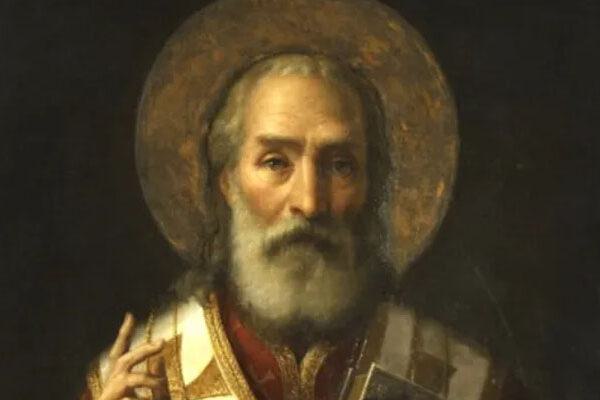By Craig Monger
You would be hard-pressed to find a solitary person on planet earth who would not recognize the figure of Santa Claus.
A stout, bearded fellow, Santa is adorned in red and white, rides a sleigh pulled by reindeer, and delivers presents to the good boys and girls worldwide. Through the years, Santa has become virtually synonymous with Christmas.
Though time has molded Santa into a cartoonish figure in the West, there is a historical reality behind the mythical figure.
St. Nicholas was a Christian bishop who lived in a Roman-occupied part of Greece called Myra (modern-day Turkey). He existed in the most significant period of the early Church, which saw tremendous Christian persecution and the establishment of the first Christian creeds.
Like many saints of the primitive Church, tradition and legend have placed mystical weight on Nicholas that he could not reasonably be expected to bear. Almost 1,800 years have passed since Nicholas lived, and the passing centuries have resulted in wild speculation, mythical invention, and downright fabrication. Even though there is very little known about Nicholas, there is no doubt that his legend has become an integral part of Christmas celebrations in the West.
There are no contemporary sources written about Nicholas, which is very common for people who existed in his time. It is documented that Emperor Theodosius II commanded the construction of the Church of St. Nicholas in Myra sometime in the 5th century, which means that Nicholas both existed and left a pastoral impression in his home city.
And so eagerly stationing him before us, unworthy as we now are, as blessed helmsman of the Word and traveling companion of God, we begin his story.
–Michael the Archimandrite
Saint Nicholas was born somewhere between AD.270 and 280 in Patara, Lycia, Asia Minor (modern-day Turkey). We know very little about Nicholas's calling, training, and ordination. Some later sources suggest he was ordained by his uncle, the Bishop of Myra, an office that Nicholas himself would later occupy.
According to tradition, Nicholas developed a reputation as a defiant defender of church doctrine during the Great Persecution, which began in AD 303 under Emperor Diocletian and ended under Emperor Constantine in AD 313 with the Edict of Milan. During the persecution, Christians were imprisoned, burned, tortured, enslaved, and murdered. Churches were razed, and Christian scriptures were burned.
Bishops and parishioners were commanded to renounce the Christian faith and sacrifice to the pagan Roman gods. Those who did not submit were imprisoned, and many met awful fates. Through this persecution, Nicholas stood firm and refused to capitulate to the demands of Rome and was imprisoned for several years.
After his imprisonment, early sources place Nicholas at the Council of Nicaea, which was called to refute the teachings of the Alexandrian Presbyter, Arius. Arius had been exiled for his heretical teachings on the Deity of Christ and rejecting the Trinitarian doctrine that had become most prevalent among the Church. Nicholas attended the Council in opposition to Arius and was known as one of his more strident opponents.
According to one legend, which has scant historical value, Nicholas became so enraged at Arius's apologetic that he crossed the room and struck Arius across the face.
The reliable source for contemporary stories involving Nicholas comes from Michael the Archimandrite's (814 – 842) Life of Saint Nicholas, which is believed to draw from the most ancient sources.
Nicholas was said to be of remarkable generosity throughout his life, constantly giving money to the poor. According to Michael, Nicholas's most widely attested legend describes his generosity to a father who had fallen destitute and could not supply a dowry for his daughter. Since the alternative to marriage would have been for the daughter to become a woman of easy virtue, St. Nicholas decided to help in his own way. Under the cover of night, Nicholas visited the man's home and threw a bag of gold coins through the window, landing in a stocking drying by the hearth.
"When the man who had been shown this mercy found the bag when it had become day, he was seized with joy and with ungovernable tears and gave thanks to God with amazement and astonishment, wondering in himself from where so great a blessing had come to him," Michael said.
According to Michael, Nicholas' generosity allowed for a sufficient dowry for the daughter, and she was later married with her honor intact.
When the man's other two daughters were also without dowry when they reached marriageable age, he threw more bags of gold through the window at night and saved their virtue as well.
It is unknown when Nicholas died, but later, many visited his tomb to pay homage to the man who had already become a legend.
Although St. Nick is associated chiefly with Christmas Day, the feast of St. Nicholas has been celebrated on Dec. 6. In Eastern Orthodoxy, Nicholas is featured heavily in the liturgy. The celebration of the feast has varied through different ages and cultures, ranging from the very charming to the macabre and bizarre.
The centuries have transformed the pious clergyman known for his zeal and generosity into a jolly fat figure who delivers toys to the good boys and girls on Christmas Eve. The famous vision of Santa Clause didn't appear until 1500 years after his death. The years have turned Nicholas into a legend. While separating the man from the myth may be difficult, it is undeniable that St. Nicholas of Myra has been cemented in history forever.
To connect with the author of this story, or to comment, email craig.monger@1819News.com.










